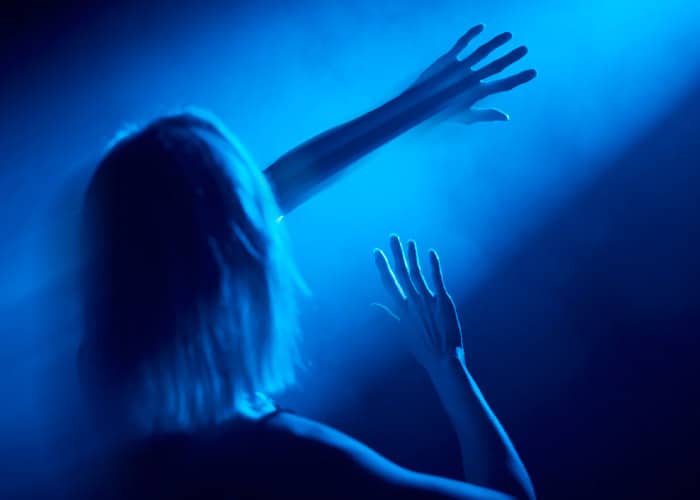Have you ever heard of blue light when searching for sleep-related content and wondered what it is? Blue light is just a part of the visible light spectrum that our human eye can see – from smartphones to televisions to gaming systems and tablets, most blue light sources are familiar, and some might even be already in your bedroom. Sunlight is the primary source of blue light, though other artificial sources include compact fluorescent light bulbs, fluorescent light, flat-screen LED TVs, LEDs, and computer monitors.
What is blue light?
Light consists of an invisible form of energy called electromagnetic radiation. Our eyes can interpret the colours of light depending on the amount of energy they have. An entire visible light spectrum can be seen in rainbows.
On the other hand, the sun produces white light, which blends all the colours of a visible light spectrum.
Blue light is a part of the visible light spectrum that can affect alertness, sleep cycles, and the process of hormone production. It has the shortest wavelength but highest energy, vibrating within the range of 380 to 500 nanometers.
Nearly a third of all visible light is considered blue light or high-energy visible.
How does blue light impact sleep?
Exposure to all light colours helps control your circadian rhythm or sleep-and-wake cycle. Fiercely, blue light messes negatively with your body’s natural ability to prepare for sleep since it blocks or suppresses a hormone known as melatonin that makes you sleepy.
The natural sleep-and-wake circle helps your body know when to perform its essential functions, and light is known for aligning circadian rhythms.
With the increasing consumption of electronics and artificial light, people are exposed to substantial high-energy light before bedtime. This light is known to trigger a portion of the brain responsible for feeling alert, increasing the heart rate, which elevates body temperature.
While blue light can enhance attention and performance during the day, turning our natural sleep-and-awake cycle to prepare us for better sleep after sunsets can negatively impact the night. The hormone melatonin is helpful during the day but obstructive at night when trying to fall asleep.
When you are exposed to blue light right before you go to sleep, it can trick your brain into thinking it is still daytime, thus interrupting your circadian rhythms, leaving you feeling awake rather than exhausted.
That is not all. Consistent misalignment of this sleep circle can also lead to several other adverse health issues, such as mental health and metabolic disorders.
What devices produce blue light?
Avoiding blue light is near impossible because we interact with it during the day and even after sunset. The most popular sources of blue light are:
- LED lights
- Fluorescent lights
- Smartphones
- Computer screens
- Televisions
- Video game systems
- Tablets
- E-readers
Although the dangers of artificial light are well-documented and we cannot avoid it, you can reduce your exposure through some simple methods.
Alleviating the effects of blue light
One of the most effective ways to mitigate exposure to artificial or blue light is to shut off the evening sources.
This includes turning off your electronic devices and dimming fluorescent and LED lighting once it gets dark. Don’t take the TV or your smartphone to the bedroom.
Consider using blue light glasses. These speciality glasses can help protect your eyes from stains caused by overexposure to artificial light.
While there is a need to have more research on the effectiveness of blue light, blue light glasses can help you fall asleep quickly and stay asleep to have a restful sleep. These glasses are commercially available and can help reduce the negative impacts of blue light by 10.6% to 23.6% without compromising quality.
But even without blue light glasses, you can quickly reduce the negative impacts of artificial light by using the tips below:
Learn to dim
If you can dim the light of your electronic devices or check if they have a night mode function that you can use to reduce the intensity of the blue light.
Observe the 20-20-20 rule
This guideline can help you reduce eye strain caused by blue light. The rule involves taking a 20-second break to view an object 20 feet away every 20 minutes if your work involves staring at the screen all day.
Buy a better lamp
Sometimes, we cannot help but do chores in bed. If you must read in bed, consider finding a better lamp that produces little blue light. Better still, get a lamp that does not produce blue light at all. For instance, orange and red lamps are ideal for bedtime reading.
Use an app
There are plenty of apps that can help you minimise blue light emission if you use your devices in bed or before bed.
Enhance your working environment
If there is light you cannot turn off or dim in your bedroom, consider using an eye mask to block them when you go to bed.
Consult with your eye doctor
Talk with your doctor about blue light protection as well as a digital device you can use to combat blue light.
Begin your day with sunlight
Another way to minimise the effect of blue light is getting your fill of daytime light exposure. Set the tone for the day to help promote wakefulness and alertness by going for a morning walk or just sitting on the patio while perusing your morning paper or having breakfast provided the sunlight is directly your eyes.
Stop staring at any screen one hour before bedtime
Try establishing a technology curfew where all your electronic devices are hidden away an hour before lights out. Find alternative activities that might help you wind down, including doing a puzzle, reading a book, or doing some stretching.

 Nectar Mattress
Nectar Mattress 


